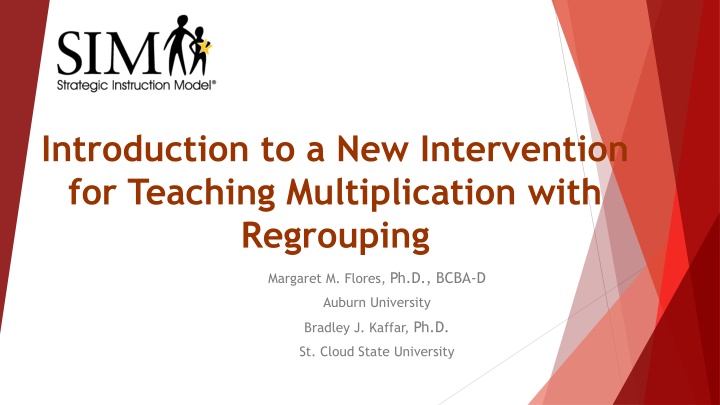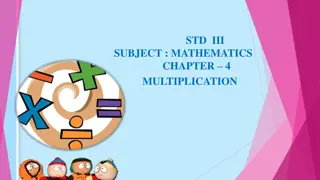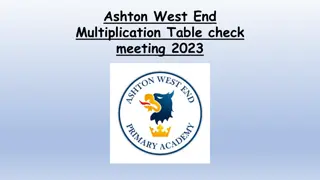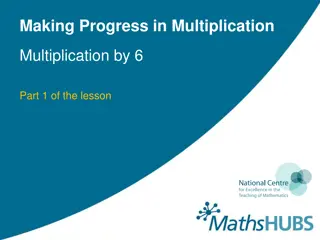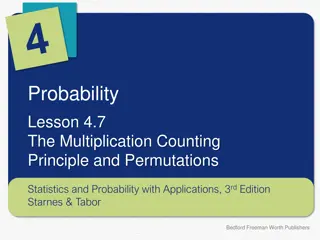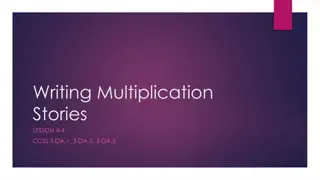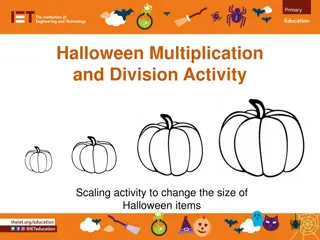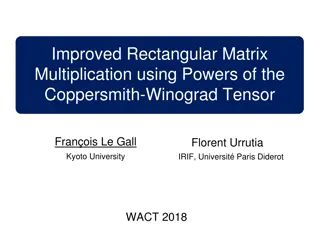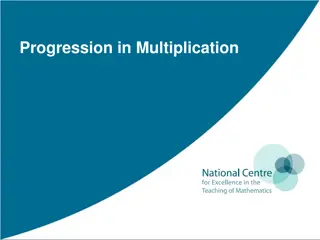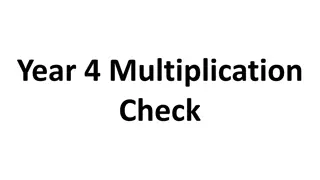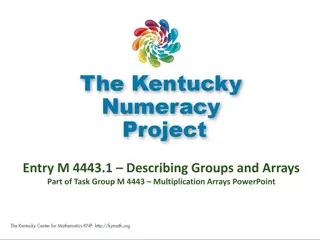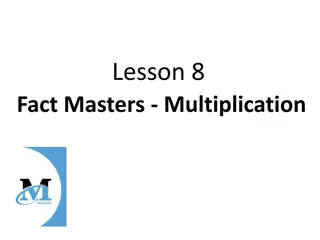New Intervention for Teaching Multiplication with Regrouping
This research project explores a novel intervention for teaching multiplication with regrouping to enhance students' understanding and mastery of this complex mathematical concept. The study, conducted by Margaret M. Flores, Ph.D., BCBA-D, of Auburn University, and Bradley J. Kaffar, Ph.D., of St. Cloud State University, aims to provide educators with effective strategies to support students in developing strong multiplication skills. By implementing this new intervention, educators can potentially improve student outcomes in math education.
Download Presentation

Please find below an Image/Link to download the presentation.
The content on the website is provided AS IS for your information and personal use only. It may not be sold, licensed, or shared on other websites without obtaining consent from the author.If you encounter any issues during the download, it is possible that the publisher has removed the file from their server.
You are allowed to download the files provided on this website for personal or commercial use, subject to the condition that they are used lawfully. All files are the property of their respective owners.
The content on the website is provided AS IS for your information and personal use only. It may not be sold, licensed, or shared on other websites without obtaining consent from the author.
E N D
Presentation Transcript
Introduction to a New Intervention for Teaching Multiplication with Regrouping Margaret M. Flores, Ph.D., BCBA-D Auburn University Bradley J. Kaffar, Ph.D. St. Cloud State University
Purpose of the Intervention Program Teach multiplication with regrouping with emphasis on the mathematical practices infused throughout the Numbers and Operations mathematics standards in most states Manual for teaching Partial Products Algorithm Manual for teaching the Standard Algorithm
Purpose (continued) Build students sense of numbers and understanding of the multiplication operation Making numbers and physically showing operations with base-ten blocks, and drawings Build students understanding of the operation in the context of real-life situations Each lesson presents computation problems with words, laying foundation for word problems After mastery of multiplication with regrouping, students differentiate between addition, subtraction, and multiplication within word problems allows students to engage in mathematical practices
The intervention is for students who demonstrate error patterns below. 2 3 2 4 2 5 3 4 2 4 3 3 x 3 6 x 1 7 x 2 3 x 1 6 x 6 8 4 7 5 1 2 2 4 1, 8 1 8 9 1 2 8 4 + 6 + 1 2 Lack of number sense 3 5 5 2 multi-digit numbers are not just separate numerals, but each one has a different value (42 is 4 tens and 2 ones rather than a 4 and 2) Students attempt to memorize steps within a algorithm without a sense of numbers or understanding meaning of the operation
Pre-requisite Skills Mastery of basic multiplication facts (zero through five) problems in manual intentionally developed so that students who have not mastered facts involving larger numbers can be successful (e.g., 8x7 or 6x9) Mastery of addition and subtraction involving regrouping Field-testing has shown that deficits in these areas will significantly interfere with student learning Manuals within the Strategic Math Series can be used to remediate Multiplication Facts 0 to 81 (Miller & Mercer, 1993) Addition With Regrouping (Miller, Kaffar, & Mercer, 2011) Subtraction With Regrouping (Miller, Kaffar, & Mercer, 2011)
Field Testing Students in public elementary and middle schools students with disabilities students at-risk for failure who received the intervention within MTSS Four studies conducted using single case designs (Flores, Hinton, & Strozier, 2014; Flores, Schweck, Hinton, 2014; Flores & Hinton, in press; Flores & Milton, in preparation) Three with larger groups of students and the results were analyzed using statistical methods Compared Multiplication With Regrouping with a Direct Instruction intervention program (Flores, Kaffar, Hinton, in press). One group, pre-test and post test (Flores & Franklin, 2014; Flores, in preparation)
Instructional Sequence Phase Purpose Lessons Mastery Criteria Pretest Lesson Lessons 1-4 Phase 1 Pretest and Commitment with Learning Contract Phase 2 Teach multiplication with regrouping at the concrete level Phase 3 Teach multiplication with regrouping at the representational level Phase 4 Teach RENAME Strategy applied to multiplication with regrouping Phase 5 Teach multiplication with regrouping at the abstract level Phase 6 Teach FAST RENAME Strategy for solving word problems Phase 7 Teach computation and problem solving at the abstract level, differentiating between operations within word problems. Teacher guidance fades. 100% 2/2 ind. practice items Lessons 5-8 100% 2/2 ind. practice items Lesson 9 100% accuracy Lesson 10 80% 4/5 ind. practice items Lesson 11 100% accuracy Lessons 12-15 85% 6/7 ind. practice items Lessons 16-18 87% 7/8 ind. practice items Post-test Lesson Phase 8 Post-test
Concrete Level Instruction (Lessons 1-4) Teach multiplication with regrouping using base-ten blocks Materials: multiplication mat, base-ten blocks, learning sheets Problems presented using words, translated into multiplication problems, problem solved using base-ten blocks and mat Examples (Lesson 3): There are 15 bags of candy and 24 candies in each bag. How many pieces of candy all together? There are 23 students and each completes 24 assignments each week. How many assignments were completed? __ groups of __ __ x __ __ groups of __ __ x __ 15 23 x 24 x 24
Representational Level Instruction (Lessons 5-8) Teach multiplication with regrouping using drawings Materials: learning sheets that include multiplication table Problems presented using words, no prompts for translation, problem solved using drawings Example (Lesson 7): There are 14 shelves of books, 24 books on each shelf. How many books altogether? 14 x 24 Hundreds Tens Ones
RENAME Strategy Bridge between representational and abstract phases Simple generalizable strategy that assists students in remembering procedures for each algorithm Teach strategy within context using problems Students memorize strategy before moving to abstract level and using the RENAME strategy to solve problems.
RENAME Strategy for Each Algorithm Partial Products Read the problem. Examine the ones column of the multiplier to make equations Note the ones partial products. Address the tens column of the multiplier to make equations. Mark the tens partial products. Examine the columns, add, and check. Standard Algorithm Read the problem. Examine the ones column. (10 or more go next door.) Note the ones. Address the tens column. (10 or more go next door.) Mark the tens. Examine the columns, begin again, or add and check.
Beginning Abstract Instruction (Lesson 10) Solve multiplication word problems and computation problems using RENAME Examples (Lesson 10): There 35 classes with 25 students in each class. How many students in all? 35 x 25
FAST RENAME Strategy Simple generalizable strategy that assists students in thinking about how to solve a word problem Find what you are solving for. Ask yourself, What are the parts of the problem? Set up the numbers. Tie down the sign. Teach strategy within context of solving different word problems Students memorize FAST strategy
Abstract Instruction, Fluency, Differentiation Between Operations in Word Problems (Lessons 12-18) Solve word problems that require addition, subtraction, or multiplication with regrouping Solve computation problems using multiplication with regrouping Teacher modeling and guidance faded until all items are independent practice in lessons 16-18 Examples (Lesson 14) There are 14 boys in the class and 17 girls in the class. How many students are in the class? Write and solve. There are 12 football teams and each team has 36 players. How many players in all? Write and solve. There are 42 students on soccer teams. There are 56 students on hockey teams. How many more students are on hockey teams?
Fluency Regrouping Rate Assessments: administer after students complete lesson 12 3 versions (A, B, C), administer by rotating versions across lessons 2-minute timed multiplication with regrouping assessment To assess retention from previous session, administer before lessons Fluency defined as 30 correct digits written What is a correct digit? 1 2 5 3 5 0 0 0 5 2 1 7 5 2 5 3 5 0 5 x 1 x 1 1 6 5 0 2 2 correct digits 2 correct digits 3 correct digits 3 correct digits 3 correct digits 1 2 correct digits 3 correct digits 3 correct digits + 2 3 + 2 3
Practice Games Beginning with Lesson 17, the last lesson activity is Game Practice supplemental practice in which students compete with each other in solving computation problems Example Object of game is to be first to complete problems correctly; use dice to determine how many problems are completed within a student s turn Roll numbers 1-5, complete one problem Roll double sixes, can complete 2 problems Roll one six, lose turn
Intervention Summary 18 lessons that teach multiplication with options of using partial products or standard algorithms Emphasis on understanding the operation and its application to real-life situations Lesson sequence Concrete Problem solving using base-ten blocks Representational Problem solving using drawings> Abstract Computation fluency and discrimination between operations within word problems Problem solving using > numbers only >
